-
Paper Information
- Paper Submission
-
Journal Information
- About This Journal
- Editorial Board
- Current Issue
- Archive
- Author Guidelines
- Contact Us
International Journal of Applied Sociology
p-ISSN: 2169-9704 e-ISSN: 2169-9739
2015; 5(2): 99-105
doi:10.5923/j.ijas.20150502.05
Low Carbon City Policy Implementation in Muangklang Municipality, Thailand
Parichat Pongloe1, Andy Fefta Wijaya2, Lely Indah Mindarti2
1Master Program of Public Administration, Faculty of Administrative Science, University of Brawijaya, Indonesia
2Department of Public Administration, Faculty of Administrative Science, University of Brawijaya, Indonesia
Correspondence to: Parichat Pongloe, Master Program of Public Administration, Faculty of Administrative Science, University of Brawijaya, Indonesia.
| Email: |  |
Copyright © 2015 Scientific & Academic Publishing. All Rights Reserved.
The world is facing a significant change in climatic conditions, with global warming issue. Muangklang Municipality is an example of the city that has development policies and measures to reduce GHG. The prior conditions to implementation under four guiding strategies (City of Trees, City of Waste Minimization, City of Energy Efficiency and City of Sustainable Consumption) can be viewed. First, due to the limited space in Muangklang Municipality and also decreased space caused by urban development, it is hard to upgrading the number of green space and planting more trees. Second, there is tons of municipal waste that generated and fulfilling the landfill pit out of town, particularly the waste from municipal market or fresh market with lots of local vendors and purchasers that contributed to a large amount of waste in a daily basis. Third, increasing number of vehicles in municipal area that caused increasing volume of carbon dioxide gas and human activities that using electricity consumption are among the contributors of climate change problem. Last, the environmental issues above are worsened by the lack of the people participation in identifying and resolving the issues. The researcher wants to study about the implementation of Low Carbon City policy, including the roles of stakeholders. This study found that Muangklang municipality implements the policy under control of environment bureau. Even in Low Carbon City policy implementation in Muangklang municipality, every form of responsibility for the overall implementation of Low Carbon City Policy implementation held by the Mayor and the head of each division. Mayor and the head of each division have the authority and decisions, to determine the required information and integrate it from each division. So that can determine the strategy and management in running the implementation. People or Stakeholders have to follow the guide from leader.
Keywords: Low Carbon City, Policy Implementation, Muangklang, Thailand
Cite this paper: Parichat Pongloe, Andy Fefta Wijaya, Lely Indah Mindarti, Low Carbon City Policy Implementation in Muangklang Municipality, Thailand, International Journal of Applied Sociology, Vol. 5 No. 2, 2015, pp. 99-105. doi: 10.5923/j.ijas.20150502.05.
Article Outline
1. Introduction
- The world is facing a significant change in climatic conditions, with global warming issue. Coming to the first place, the Intergovernmental Panel on Climate Change (IPCC) has pointed to the fact that global warming is the result of increasing concentrations of Greenhouse Gases (GHG) in the atmosphere. It is widely accepted that human activity is the main source of such emissions and thus there is an anthropogenic cause to global warming [1], and publishes Assessment Reports on September 27, 2013. The report finds that there is robust evidence that multiple components of the Earth’s climate system are changing, including rising global air and ocean temperatures, widespread melting of snow and ice, rising global average sea level, and changes in many extreme events. [2]Thailand is one of the largest economy powerhouses in Southeast Asia region, but at the same time the rapid industrial development has also led to serious environmental problems threatening the survival of Thai people. For the past few decades, environment in Thailand has become more and more troublesome, as Thailand has been transforming from a traditional agricultural country to an industrial development country. There are six specific environmental problems in Thailand including climate change, intensive farming, water pollution, air pollution, resource depletion, and waste generation. [3] Therefore, Thailand has prepared the “Thailand Climate Change Master Plan 2012-2050 (B.E. 2555-2593)” up.Among rapid Economic and Industrial Development ends, as a result, there are four types of industrial zone: industrial estates, industrial business zones, industrial communities and industrial parks. The total area of all types of industrial zones covered only 1.8% of the entire Rayong Province region. There are 1,910 industrial facilities and occupying are about 6,400 hectares. Muangklang Municipality is an example of the city that has development policies and measures to reduce GHG. The municipality intends to be low carbon city and has continuously implemented environmental and energy projects, resulted in several nominations for awards on environment and climate change. The awards include the award on livable and sustainable municipality in 2005, the certification on ISO 14001 (including energy management as well) in 2006, and the participation in the Cities for Climate Protection Campaign in the ASEAN level since 2005. [5]Muangklang firstly surveyed its key economic and social activities, engaging stakeholders from multiple sectors across all 13 communities in the municipality. The municipality gathered activity data to prepare a detailed GHG emission inventory for each key emitting sector for year 2010, with commercial and residential buildings, transportation, industry, waste, and agriculture and forestry comprising total emissions. This inventory served as a baseline from which to identify potential emission reduction opportunities within the top emitting sectors as show on Figure 1 below [6].
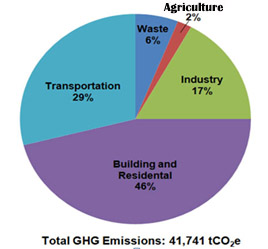 | Figure 1. Muangklang GHG emission by sector |
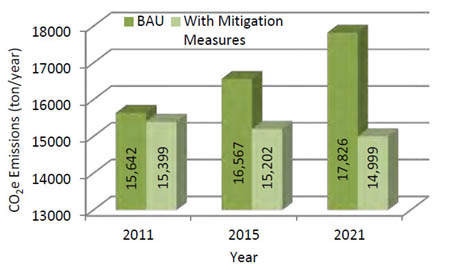 | Figure 2. Muangklang residential buildings sector GHG emission trends |
2. Theoretical Concept
2.1. Implementation Model by G. Edward III
- Edward saw the policy implementation as a dynamic process, there are many factors that interact and influence the effectiveness of the policy implementation. Edward III [7] said that “in our approach to the study of policy implementation, we begin in the abstract and ask: What are the preconditions for successful policy implementation? What are primary obstacles to successful policy implementation?”. Therefore, Edward considered to four key issues that play important role in achieving successful implementation based on its effectiveness. The Four key issues are communication, resources, disposition or attitudes, and bureaucratic structure [8] (Figure 3).
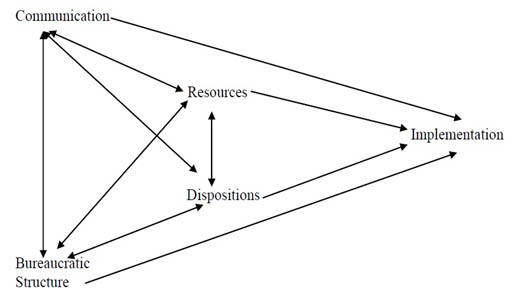 | Figure 3. Implementation model by George C. Edward III [7] |
2.2. Policy Implementation Theory
- The three generations of implementation research presented earlier can be subdivided into three distinct theoretical approaches to the study of implementation (Figure 4).
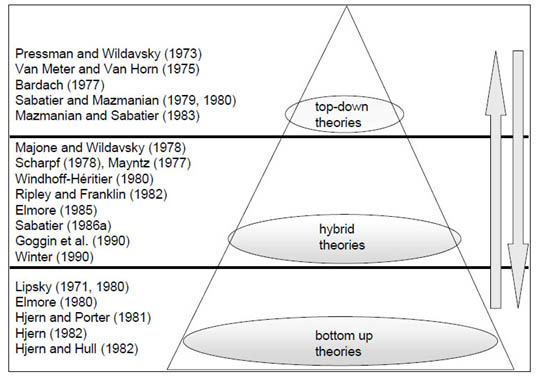 | Figure 4. Top-down, bottom-up, and hybrid theories: key contributions [9] |
3. Research Methodology
- The approach that will be applied in this research is qualitative methods.
3.1. Data Collecting Method
- To collect data, the researcher used the data collection techniques as follows1. Interviews; which is a data collection technique whereby researchers dealing directly with the person that are responsible for implementing. 2. Documentation; that is data collection techniques in a way to collect material from various documents. 3. Observation; the researcher will observe indirectly and making note about the result.
3.2. Data Analysis Method
- According to Miles and Huberman [10], observed that qualitative data analysis is a continuous, iterative enterprise. Issues of data condensation, display, and conclusion drawing/verification come into play successively as analysis episodes follow each other. Such a process is actually no more complex, conceptually speaking, than the analysis modes quantitative researchers use.
4. Results and Discussion
- Thailand recognizes climate change issues at the international and national level. The 11th National Economic and Social Development Plan (2012-2016), cites global warming as a key concern that influences future national development.There are also several regulations that are related to climate change. The overview of Thailand’s relevant regulation is summarized as presented below on Figure 5.
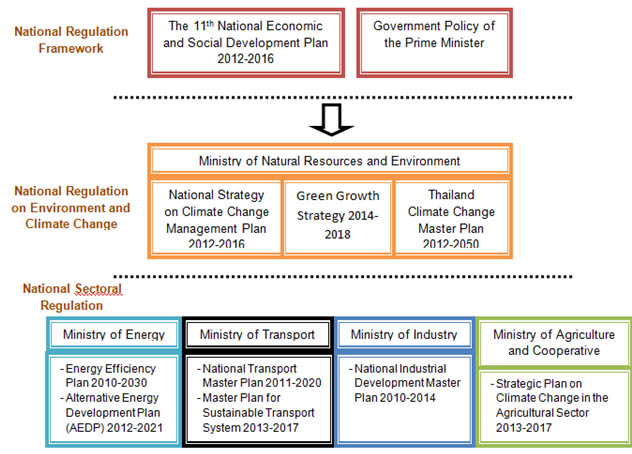 | Figure 5. Relevant regulation concerning on climate change |
4.1. Bureaucracy Structure
- Municipality is the lowest level municipal unit in Thailand, and usually translated as sub-district municipality. Figure 6 below presents the structure of Muangklang municipality as mentioned in the regulation.
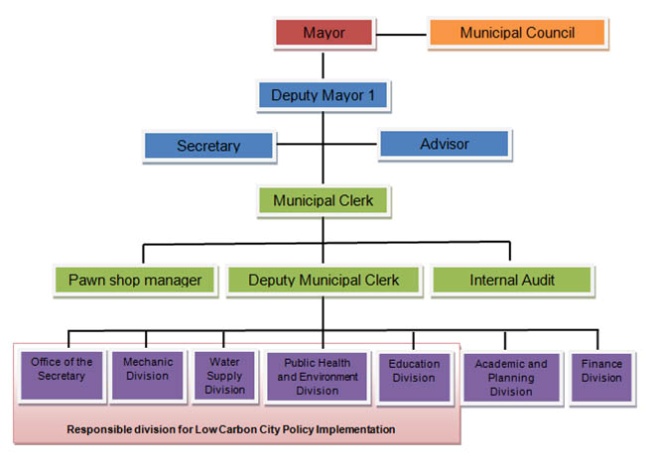 | Figure 6. Muangklang municipality administrative structure |
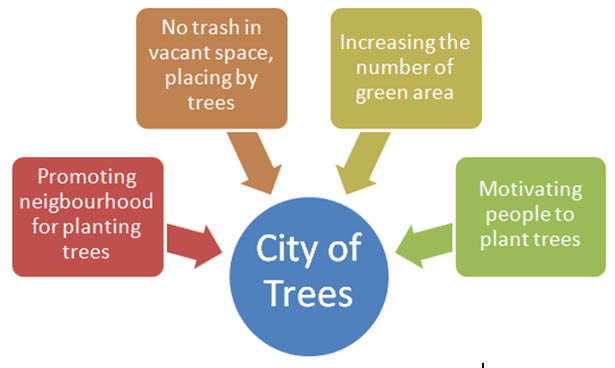 | Figure 7. The idea of City of Trees in Muangklang municipality |
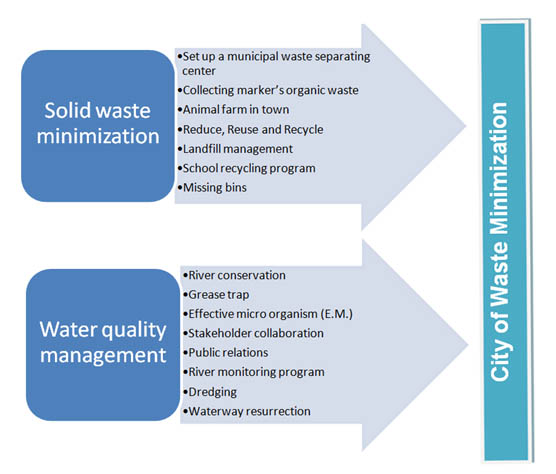 | Figure 8. The idea of City of Waste Minimization in Muangklang municipality |
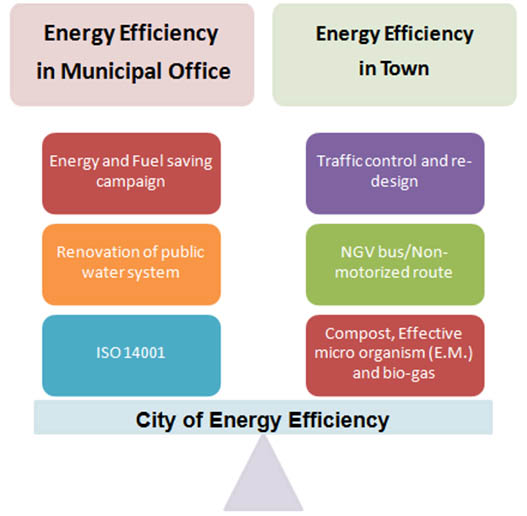 | Figure 9. The idea of City of Energy Efficiency in Muangklang municipality |
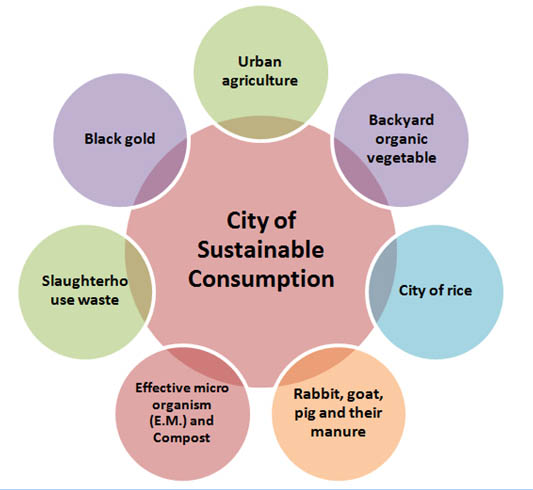 | Figure 10. The Idea of City of Sustainable Consumption in Muangklang municipality |
4.2. Communication
- As we know, the concept and policy of Low Carbon City is considered and established as regulations both in national and local level. So Muangklang municipality got the information or idea from government clearly, then reach the goal of what so called as “Low Carbon City” and the clear steps to take to reach the goal together with all stakeholders. According to Edward [7] that; Information needs to be communicated to stakeholders in order to understand what is the content, purpose, direction, target group (target group) policy, so that stakeholders can prepare any matters relating to policy implementation. Besides that, the policy implementation process can run effectively and in accordance with its policy goal. And for the consistency to stick to the Low Carbon City policy is important for ensuring the sustainability of the policy implementation, particularly in the issue of human resources and budgetary as seen in data finding. Muangklang municipality also have channels to communicate with stakeholders, especially people on Low Carbon policy implementation through various channels, such as Community Radio, Broadcast Tower, Signboard and so on. It consistent with Peeraya Vajarodaya [11] has written a research entitled “Local Authority’s Solid Waste Management: A Case Study of Muangklang Municipality, Rayong Province”. He found several channels to provide the knowledge to local people.
4.3. Available Resources
- Muangklang municipality was the brand new to be Low Carbon City Model. So, available resources are the important elements to success implementation. Firstly, human resource in Muangklang municipality; that the comparison between the number of government officer and municipal employee is so different, especially on Public Health and Environment Division. Consistent with Peeraya Vajarodaya [11] has written a research entitled “Local Authority’s Solid Waste Management: A Case Study of Muangklang Municipality, Rayong Province”. The result showed relevant Staffs were enthusiastic with skills in solid waste management. However, the numbers of operation staffs were not enough. But not important at all, those employees have been running the responsibilities and duties as well and the mayor has supported them to train more in specific work of each person that consistent with Chamlong Poboon [5]. He has written a research entitled "Local Authority and Global Warming Mitigation: A Case Study of Muangklang Municipality" and found the learning and development perspective in municipality, had developed all relevant officers to adopted the ISO 14001 system in municipal. Secondly, Muangklang municipality has the normal budget by self collection and subsidies from the government. Muangklang municipality used that budget for Low Carbon City policy implementation but from the Muangklang municipality Revenues and Expenditures Budget are similar with revenues over expenditures. Because Muangklang municipality can get revenues came from the waste collection fees and brainchild of Low Carbon policy product. If in big project, Muangklang municipality was supported by other organizations to implement the low carbon policy. About Budget has been mentioned in several researches, including Athapol Ruengrong [12], Surawut Chomaitong and Ranjith Perera [15] and Chamlong Poboon [5]. And lastly, Muangklang Municipalit has building to do work and all complete office equipments. Although the equipment that used in implementation have highly valued but the municipality gradual added more by used equipment or invented. The municipality has limited land, the mayor is necessary to manage the land. And with that the municipality was in serious to develope and resolve, therefore been donated some land from the public, private sectors and government organizations.
4.4. Disposition
- The mayor can changed the attitude of the municipal officers in the municipality to the same goal of bringing this policy into practice. By initiating change within office then build confidence of people, it is a huge challenge because the municipality cannot work alone. When they see a change in a better way and self-interest, it will be the cooperation of all stakeholders on implementation. Additionally, Muangklang Municipalit is also a good example to other organizations to study to implement town to Low Carbon City. As clear by Edward [7] that “Their attitudes, in turn, will be influenced by their views toward the policies and by how they see the policies affecting their organizational and personal interests.”Overview of the Low Carbon City Policy Implementation in Muangklang municipality is top – down approach, that any form of responsibility for the overall implementation of Low Carbon City Policy implementation held by the Mayor and the head of each division. Mayor and the head of each division have the authority and decisions, to determine the required information and integrate it from each division. So that can determine the strategy and management in running the implementation. This also supports Low Carbon Policy implementation can run well in Muangklang municipality and make Muangklang municipality as the best of Low Carbon City in Thailand.
5. Conclusions and Suggestion
5.1. Conclusions
- Muangklang municipality decided to take a new development approach under the concept “Livable city and sustainable living” to be “Muangklang Low Carbon City Model” that related to the 11th National Economic and Social Development Plan 2012-2016) and National Regulation on Environment and Climate Change as National Strategy on Climate Change Management Plan 2012-2016, Green Growth Strategy 2014-2018 and Thailand Climate Change Master Plan 2012-2050. Muangklang municipality implements the policy under control of environment bureau. Even in Low Carbon City policy implementation in Muangklang municipality, every form of responsibility for the overall implementation of Low Carbon City Policy implementation held by the Mayor and the head of each division. Mayor and the head of each division have the authority and decisions, to determine the required information and integrate it from each division. So that can determine the strategy and management in running the implementation. People or Stakeholders have to follow the guide from leader.
5.2. Suggestion
- There are suggestions for the Low Carbon City Policy Implementation in Muangklang Municipality and roles of stakeholders in Low Carbon City policy that could be derived from this research, namely:1) Evaluate and establishing a new initiative to adapting to the current situation of low carbon issue, particularly to be flexible to new technology.2) Increasing channels of communication with the public and stakeholders in order to ensure the policy and regulations concerning environmental issue are delivered in the clear and prompt manner in regular basis.3) Giving the education to municipal officers and local people to know and understand policy clearly, so that turning the policy as their way of life.4) Motivating local people to create the way to reduce GHGs in daily life by themselves and encouraging the local wisdom as the problem-solving in low carbon issue.5) Improving the roles of stakeholders, especially the local people, to participate on policy implementation and evaluation, thus directing the current and future policy in low carbon issue is closed related to the real problem faced by the local people.
 Abstract
Abstract Reference
Reference Full-Text PDF
Full-Text PDF Full-text HTML
Full-text HTML